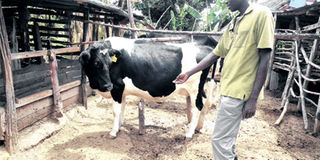How I made my cows give six times more

Robert Rotich at his dairy farm, where he also produces biogas. PHOTO | ANDREW MIBEI |
What you need to know:
- When he inherited the cows, crossbreeds of indigenous and exotic breeds, they were producing a total of 11 litres of milk a day, earning him an average of Sh2,000 a month.
- The cost, however, increases if a farmer chooses sexed semen that goes for at least Sh6,000 per straw.
- Bomet livestock production officer Evans Kiplagat says many cows produce low quantities of milk a day because of poor feeds and breeds.
Robert Rotich whistles a popular Kalenjin song as he milks one of his three cows in Kipsuter village, Chepalungu Constituency.
The look on his face shows the farmer is enjoying the task.
After he completes milking the first cow, he empties the milk in a can before moving to the next animal.
The exercise takes him over an hour that evening, and when he is done, he has 36 litres, having milked a similar amount in the morning. He delivers the milk to a cooperative society.
The about 70 litres are more than six times what he used to get five years ago from the cows.
Over the years, Rotich who inherited three dairy cows from his father, has worked hard to boost their production.
When he inherited the cows, crossbreeds of indigenous and exotic breeds, they were producing a total of 11 litres of milk a day, earning him an average of Sh2,000 a month.
HOW HE DID IT
Today, each of his Friesian cow produces over 20 litres a day. So what did he do?
“I noticed that one of the major causes of the low production was feeds. The animals were not getting quality fodder. I, thus, subdivided my four acres into quarter-acre plots to create paddocks. I planted napier grass on two pieces and the rest lucerne and Rhodes grass,” says Rotich, who sub-divided the land after talking to livestock extension officers in the region that experiences long dry spells.
Feeding the animals quality fodder saw his milk production rise to 18 litres a day in total.
Assured of good feeds, the farmer moved to improve the cow breeds through artificial insemination (AI).
By then, Rotich had joined Siongiroi Dairy Cooperative Society through which he sourced AI services.
“Initially we would depend on freelance livestock officers, who used to do the work from as low as Sh1,000. But I learned that this compromised quality. I registered my animals with the cooperative to get AI services that have seen me end up with Friesian cows,” says Rotich, who notes that one of his major challenges is lack of water, which he sources from a river that is half-a-kilometre from his home.
The cost of inseminating a cow through the cooperative ranges from Sh1,000 to Sh3,000. Local semen is cheaper compared to the imported one.
The cost, however, increases if a farmer chooses sexed semen that goes for at least Sh6,000 per straw.
He now has 10 animals, the four that are lactating, three calves and the rest heifers, which are in-calf.
To ensure his animals get quality feeds, Rotich mixes lucerne with chopped Rhodes and napier grasses.
Today, from the 70 litres of milk he gets daily, he earns over Sh50,000 a month, up from Sh2,000 five years ago.
He delivers milk twice a day to the cooperative that in turn sells to Brookside Dairy Ltd at Sh30 per a litre.
He makes biogas from the cow dung and this saves him money he would have spent on cooking gas.
He recently bought a three cubic metre plastic biogas digester on loan. He uses the slurry from the digester to grow his fodder, thus saving money he would have spent on fertiliser.
LOW PRODUCE
Bomet livestock production officer Evans Kiplagat says many cows produce low quantities of milk a day because of poor feeds and breeds.
“A farmer should know the breed of the dairy animal to rear in his region. Most cows produce low milk because they may not be suitable for some regions In Bomet County for instance, the best animals to keep are the Ayrshire, because they can withstand high temperatures.
Friesian cows also do well but they are not hardy, besides, they consume more,” Kiplagat says.
He advises farmers to adopt intensive dairy practices to maximise their milk production.
“It is possible to get even up to 30 litres a day from a cow that (now) produces three litres. What matters is how and what you feed the animals. You can get from your cow as much as you wish.”




